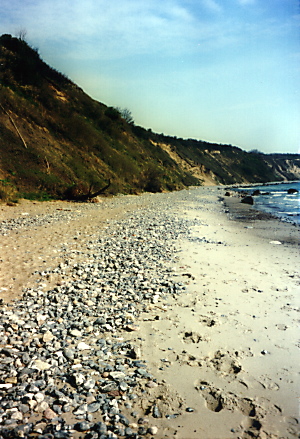Flint
Flint is a hard, sedimentary cryptocrystalline form of the mineral quartz, categorized as a variety of chert. It occurs chiefly as nodules and masses in sedimentary rocks, such as chalks and limestones. Inside the nodule, flint is usually dark grey, black, green, white, or brown in color, and often has a glassy or waxy appearance. A thin layer on the outside of the nodules is usually different in color, typically white and rough in texture.
Formation[edit | edit source]
Flint is formed through a process of chemical precipitation from silica-rich solutions. This process typically occurs in marine environments where the silica is derived from the skeletal remains of marine organisms such as sponges and diatoms. Over time, the silica-rich solutions percolate through the sediment, precipitating out as nodules of flint.
Uses[edit | edit source]
Flint has been used by humans for thousands of years, primarily for tool-making. The sharp edges that can be produced by flaking flint made it an ideal material for prehistoric tools and weapons. Flint tools are a key component of the Stone Age archaeological record. In more recent history, flint was used in the production of flintlock firearms, where a piece of flint was used to produce a spark to ignite the gunpowder. Flint is also used in the production of certain types of ceramics and as a decorative stone in buildings.
Geographical Distribution[edit | edit source]
Flint is found in many parts of the world. Significant deposits are located in the United Kingdom, particularly in the South Downs and North Downs regions. Other notable deposits are found in France, Germany, and the United States.
Cultural Significance[edit | edit source]
Flint has played a significant role in human history. The ability to create sharp tools from flint was a major technological advancement for early humans. Flint tools and weapons were essential for hunting, food preparation, and construction. The use of flint in flintlock firearms also had a significant impact on the development of modern weaponry.
See Also[edit | edit source]
References[edit | edit source]
External Links[edit | edit source]
Navigation: Wellness - Encyclopedia - Health topics - Disease Index - Drugs - World Directory - Gray's Anatomy - Keto diet - Recipes
Search WikiMD
Ad.Tired of being Overweight? Try W8MD's physician weight loss program.
Semaglutide (Ozempic / Wegovy and Tirzepatide (Mounjaro / Zepbound) available.
Advertise on WikiMD
WikiMD is not a substitute for professional medical advice. See full disclaimer.
Credits:Most images are courtesy of Wikimedia commons, and templates Wikipedia, licensed under CC BY SA or similar.Contributors: Prab R. Tumpati, MD






